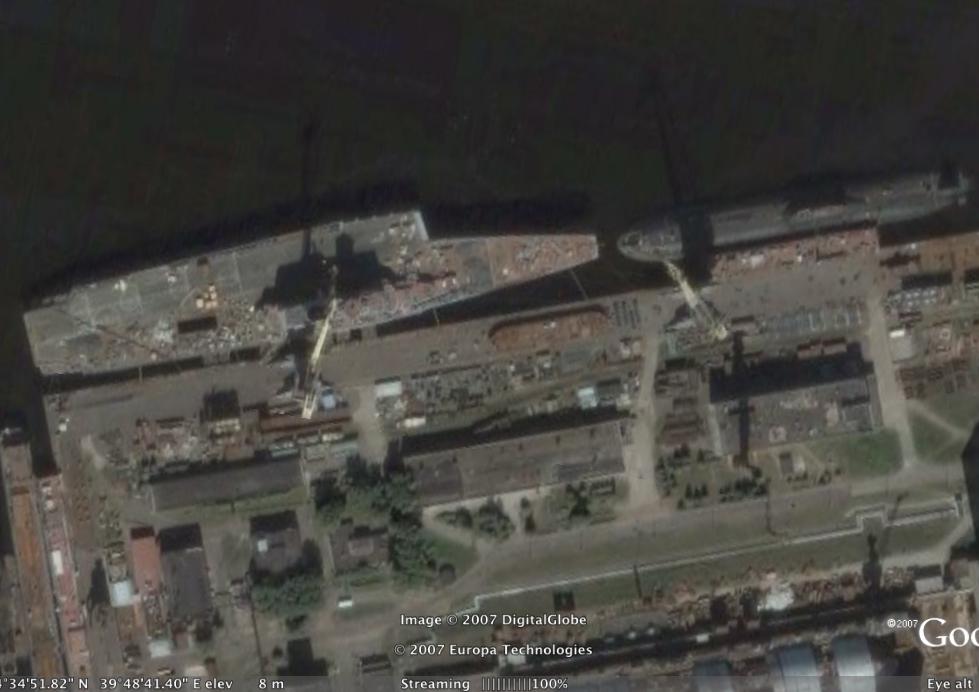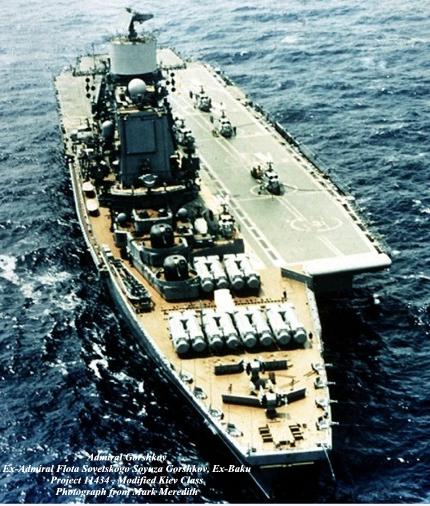Anyway, for a Navy Officer of a certain age there is a strange word that means something ominous; Severodvinsk.
Off the White Sea; to me she always represented some dark, cold abyss that monsters lay in wait to haunt the open seas. Go there now to look at where we are in 2007. Still plenty of monsters, but not that scary.
Spend some time cruising around the harbor (heck, some people are really in to it) - but let's look at N64 34.9/E039 48.7 a bit. There they are.

On the left you have the last of the Kiev class Carriers, the Admiral Gorshkov (nee Baku), being refurbished into the INS Vikramaditya. On the right - he11 on wheels herself - a Typhoon. See the ducted prop there? What people wouldn't have given to have seen that up close 25 years ago (though I am sure we did anyway).
Anyway, lets get back to the Baku. Back in the day, how about this lineup?
- 6 × twin SS-N-12 Sandbox SSM launchers (12 missiles).
- 24 × 8-cell SA-N-9 vertical SAM launchers (192 missiles).
- 2 × 100 mm guns
- 8 × AK-630 30 mm CIWS.
- 10 × 533 mm torpedo tubes.
- 2 × RBU-6000 anti-submarine rocket launchers.
- 12 Yak-38M fighter aircraft.
- 20 Kamov Ka-25 or Kamov Ka-27 helicopters.
A bit more modern approach from the Indians.The P-500 Bazalt (Russian: П-500 «Базальт»; English: basalt) is a liquid-fueled, rocket powered, supersonic cruise missile used by the Soviet Navy. Developed by OKB-52 MAP (later NPO Mashinostroyeniye). Its GRAU designation is 4K80[1]. And its NATO reporting name is SS-N-12 Sandbox. It entered service in 1973 to replace the SS-N-3 Shaddock. The P-500 Bazalt had a 550 km range and a payload of 1,000 kg, which allows it to carry a 350 kT nuclear or a 950kg semi-armor-piercing high explosive warhead (currently only the conventional version remains in service). The P-500 Bazalt uses active radar homing for terminal guidance, and can receive mid-course corrections by the Tupolev Tu-95D, the Kamov Ka-25B and the Kamov Ka-27B.
The P-500 Bazalt was first deployed in 1975 on the Soviet aircraft carrier Kiev, and was later added to both the Echo II class submarine and the Juliett class submarine. A version of the P-500 Bazalt with improved guidance and engines is used on the Slava class cruiser.
The P-700 Granit (NATO reporting name SS-N-19 Shipwreck) was partially based on the SS-N-12, but with a turbojet engine and a significantly modified airframe. The avionics, however, are very close
8 CADS-N-1 Kashtan CIWS.The look is radically different as well. The beauty and the beast; past and present; fading Empire - and rising Power.
16 MiG-29K, HAL Tejas, or Sea Harrier.
6 Ka-31 'Helix'.


UPDATE: Wretchard over at The Belmont Club is looking too.
No comments:
Post a Comment